CeoTronics CT-DECT-M24 CT-DECT-M24 User Manual CT GateCom System II
CeoTronics AG CT-DECT-M24 CT GateCom System II
Contents
- 1. users manual
- 2. revised users manual
users manual

CT-GateCom II.24
Full duplex communication system for aircraft push-back
Description and Operation
Contents
1. Important safety instructions ............................................................................................................. 2
2. Description ........................................................................................................................................ 5
2.1 General.......................................................................................................................................... 5
2.2 Communication circuits ................................................................................................................. 5
2.3 System overview ........................................................................................................................... 5
2.4 Communication Headsets ............................................................................................................. 5
2.5 Transmitter/Receiver Unit CT-GateCom II.24/Multi....................................................................... 9
2.6 Transmitter/Receiver Headset CT-GateCom II.24 ........................................................................ 9
2.7 Aircraft Interface CT-GateCom II.24+4........................................................................................10
2.8 Battery chargers .......................................................................................................................... 11
3. On-air subscription.......................................................................................................................... 12
3.1 General........................................................................................................................................ 12
3.2 On-air subscription of the first Transmitter/Receiver Unit of group 1........................................... 13
3.3 On-air subscription of the second Transmitter/Receiver Unit of group 1..................................... 13
3.4 On-air subscription of the first and second Transmitter/Receiver Unit of group 2 ....................... 13
4. Commissioning and operation......................................................................................................... 14
4.1 Aircaft Interface ........................................................................................................................... 14
4.2 Headsets and Transmitter/Receiver Units................................................................................... 14
4.3 Switching on, adjusting the speaker volume ............................................................................... 15
4.4 Connection setup and release by the Transmitter/Receiver Unit(s) ............................................ 15
4.5 End of operation .......................................................................................................................... 16
5. Safekeeping – storage .................................................................................................................... 16
6. Recharging the batteries................................................................................................................. 16
7. Maintenance.................................................................................................................................... 17
7.1 Visual inspection.......................................................................................................................... 17
7.2 Cleaning ...................................................................................................................................... 17
7.3 Replacing the windshield on the headset microphone ................................................................ 17
7.4 Replacing the ear cushions of the headset muffs........................................................................ 17
8. Accessories and consumable parts ................................................................................................ 17

2
1. Important safety instructions
When using CeoTronics products do not fail to comply with the following safety
information:
zBefore using CeoTronics products read completely the appropriate operating instructions. If in doubt,
ask our technical staff.
zIf repair work of any kind needs to be done to CeoTronics products, arrange for it to be performed
only by the company CeoTronics or by a specialized workshop that is authorized by CeoTronics. In
all other cases our warranty and liability for the product shall lapse.
zIf products are operated on a mains voltage, always pull the mains plug out of the mains plug socket
before opening such products (e.g. for servicing purposes) !
zDo not store CeoTronics products outside or in damp ambient conditions. At all times keep them
clean, dry and at normal air humidity. CeoTronics products must not be stored in areas with a
temperature of over +80° C (+176° F), e.g. in the summertime on the parcel shelf of a car. If not
stated otherwise, the following temperature ranges are allowed for CeoTronics products: -10 to
+55° C (+14 to +131° F) for operation, -40 to +80° C (-40 to +176° F) for storage.
zDo not immerse a CeoTronics product into water, if it is not expressly specified for this purpose.
zWhen using CeoTronics products that are equipped with connection leads ensure that the latter do
not get caught up in operational machinery or wheels !
zType-tested muffs with a high degree of passive noise attenuation are used for CeoTronics headsets
with headset muffs. If not stated otherwise, it is our experience that the passive noise attenuation of
the headset muffs is reduced by approx. 3 dB due to the electronics that are integrated into the
headset muffs. As a rule no empirical values are available for non-standard products.
At very high noise levels that exceed the passive protective effect of the headset muffs we
recommend that ear plugs be worn as an additional measure. If in doubt, ask your safety officer or
company doctor. Full noise attenuation exists only if the muff padding is in perfect condition. This
should be replaced at the latest after every 6 months of use.
zIn the case of headsets with headset muffs that protect against harmful ambient noise and that are
not equipped with additional electronics for level-limited ambient sound reception, take heed that the
audibility of warning signals, warning calls etc. is also impaired !
zCeoTronics products that are not intrinsically safe (explosion-proof) and therefore have no special
explosion-proof designation must never be operated in potentially explosive environments (e.g.
when refuelling cars, aircraft etc.). Devices that are not explosion-proof can unintentionally trigger off
explosions in such areas !
zConnect CeoTronics accessories to a device or disconnect them from a device only when the device
is switched off.
zIf you are a cardiac pacemaker carrier, before operating a transmitter/receiver ask the manufacturer
of your cardiac pacemaker for information about any impairment that might be caused due to high
frequencies.
zFor safety reasons reception volumes in excess of 85 dB(A) are possible with a whole series of
CeoTronics products. However, these can be regulated by the user. After switching on the
communication system, set the reception volume to approx. 1/2 the available loudness volume and
then test the audible volume.
Do not set the volume any higher than is necessary. A very high volume setting can lead to
damaged hearing, particularly if it is continuous. For high volumes or noise levels wear additional ear
plugs. If in doubt, ask your safety officer or company doctor.
zWhen on board an airplane always keep a transmitter/receiver switched off. Operation of the
transmitter/receiver could affect the safety of the airplane and it is therefore prohibited. Never
operate electronic devices on board an airplane without the express approval of an authorized
member of the cabin crew.
zDo not leave CeoTronics products lying around loose in cars, e.g. on the parcel shelf. Stow these
products in a suitable, safe place in the car so that they do not present a danger to you or to other
occupants of the car, if emergency braking is effected.

3
zWhen driving a car, do not use the radio because it may distract you from the other traffic. Never use
a CeoTronics product (headset, insert earphone, induction receiver etc.) that will impair your hearing.
zCharge rechargeable batteries only with the appropriate suitable CeoTronics charger. Observe the
voltage and currency specifications, including those on the mains face (e.g. 230 V AC or 115 V AC).
Never use the charger to recharge non-rechargeable batteries.
zWhen handling rechargeable batteries comply with environmental protection regulations !
Rechargeable batteries contain toxic chemicals (e.g. cadmium). Never attempt to open a
rechargeable battery and never throw a rechargeable battery into fire. Expended (defective)
rechargeable batteries are subject to compulsory regulated waste disposal. Do not put them in the
household waste !
zEnsure that a short-circuit (risk of fire or injury) is not created across rechargeable battery terminals
or charging sockets by a short-out (bent-open paper clip, bunch of keys etc.). In such an event the
warranty shall lapse. Transport any spare rechargeable batteries in an electrically non-conducting
package in order to avoid short-circuiting the rechargeable batteries.
zKeep CeoTronics products and rechargeable batteries out of the reach of children and any other
persons who are not familiar with the handling and operation thereof.
zPackaging materials, e.g. filling materials and plastic bags are not toys and have to be kept out of
the reach of children. There is a risk of children ingesting them and choking !
zSafe operation requires clean devices. Ensure that the devices (microphones, connectors etc.) are
clean and in good condition at all times.
zCeoTronics products may only be used for the specific application envisaged.
zIf the device is to be put out of operation definitively, bring it to a local recycling plant for disposal or
send it to CeoTronics.
Important Note
Please note that any changes or modifications not expressly approved by the party
responsible for compliance will void the user’s authority to operate the equipment.
This device complies with part 15 of the FCC Rules. Operation is subject to the following two
conditions: (1) This device may not cause harmful interference, and (2) this device must
accept any interference received, including interference that may cause undesired operation.
Declaration concerning RF Radiation Exposure:
The CT-DECT.24/CT-GateCom II.24 system is considered to be a portable transceiver.
A portable device is defined to be used so that the radiating structure of the device is within
20 centimeters (7.9 in.) of the body of the user and no specific safety distance is needed.
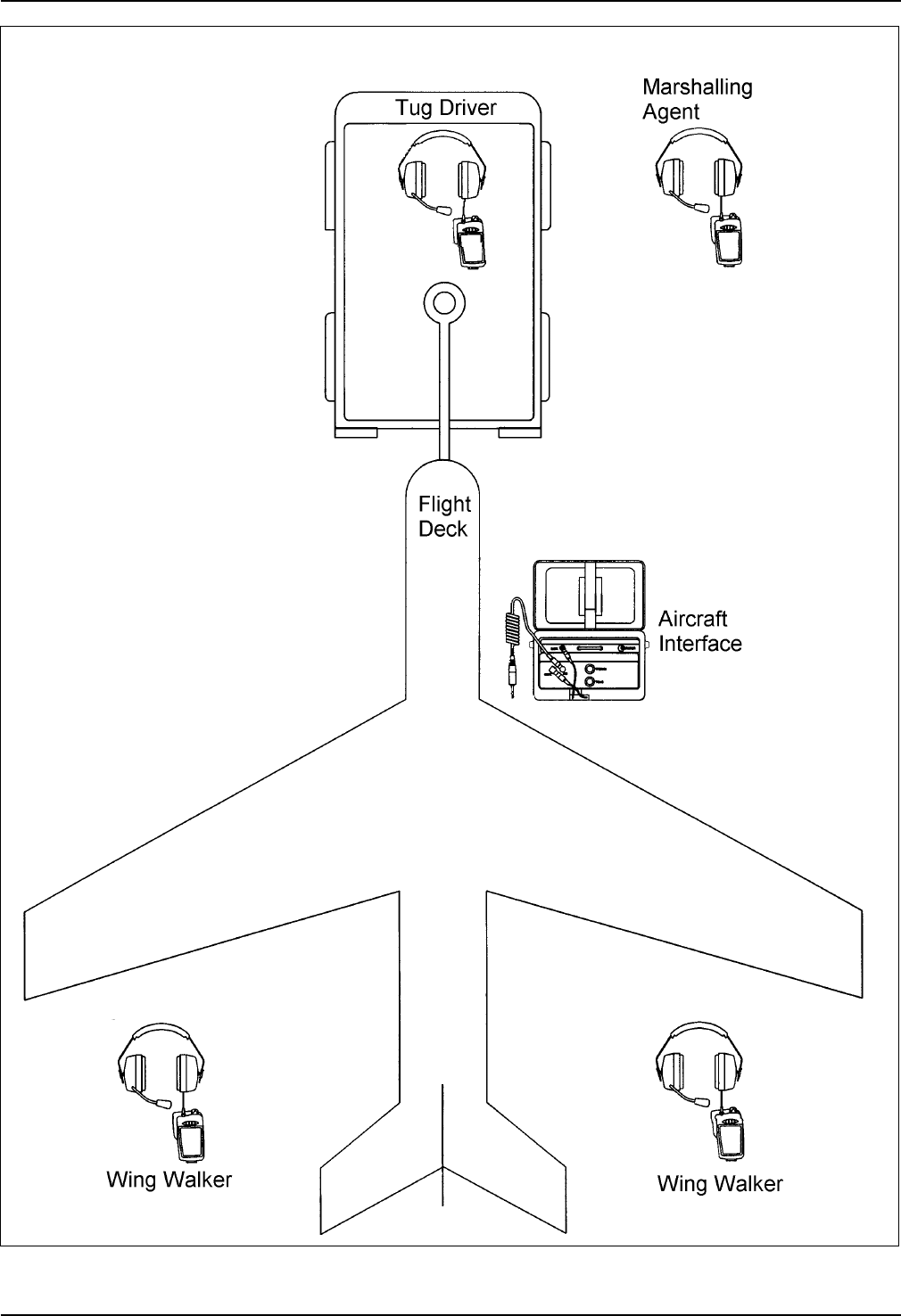
4
Fig. 1 System overview

5
2. Description
2.1 General
This duplex communication system (Fig. 1) is used for aircraft push-back. The tug driver, two wing
walkers and marshalling agent wear headsets in conjunction with Transmitter/Receiver Units »CT-
GateCom II.24/Multi«. The four headset wearers outside the aircraft can communicate with one
another. The tug driver is able to communicate with the flight deck via the Aircraft Interface that is
connected to the aircraft intercom on the outside of the aircraft. Detailed information see section 2.2.
The range depends on the local circumstances. Protection against eavesdropping is ensured by the
digital design. Channel selection is effected automatically.
2.2 Communication circuits
Wing walkers
The two wing walkers can communicate with each other, with the marshalling agent, and with the tug
driver. The wing walkers are not able to speak to the flight deck. But they are able to hear the
communication between the flight deck and the tug driver.
Marshalling agent
The marshalling agent can communicate with the two wing walkers and with the tug driver. He is able to
hear the communication between the flight deck and the tug driver. When the tug driver speaks to the
flight deck the marshalling agent can also speak to the flight deck as long as the microphone switch at
the left headset muff of the tug driver is in position »PTT« or »HOT«.
Tug driver
The tug driver can communicate with the two wing walkers, with the marshalling agent, and with the
flight deck. When he communicates with the wing walkers and/or with the marshalling agent the flight
deck doesn‘t hear this communication. When the tug driver communicates with the flight deck the two
wing walkers and the marshalling agent will hear this communication also.
The tug driver is the only person who is able to control the communication with the flight deck.
Flight deck
The flight deck can only communicate with the tug driver. The two wing walkers and the marshalling
agent can hear this communication as well. When the tug driver speaks to the flight deck the
marshalling agent can also speak to the flight deck as long as the microphone switch at the left headset
muff of the tug driver is in position »PTT« or »HOT«.
2.3 System overview
The system (Fig. 1) consists of:
yfour GroundCom Headsets
yfour Transmitter/Receiver Units CT-GateCom II.24/Multi
yone Aircraft Interface CT-GateCom II.24+4
yone charging station for up to four removable Li-Ion rechargeable battery packs 3.6 V/2300 mAh
yone single-unit charger for the Li-Ion rechargeable battery 3.6 V/2300 mAh in the Battery Pack of the
Aircraft Interface CT-GateCom II.24+4
2.4 Communication Headsets
2.4.1 General
The wing walkers, the marshalling agent and the tug driver use GroundCom Headsets in conjunction
with Transmitter/Receiver Units CT-GateCom II.24/Multi. The GroundCom Headsets protect against
harmful ambient noise and allow communication in noisy environments.
The headset microphone is noise-compensating and is equipped with a flexible gooseneck and
windshield. The microphone can be switched on and off by means of a switch at the headset muff.
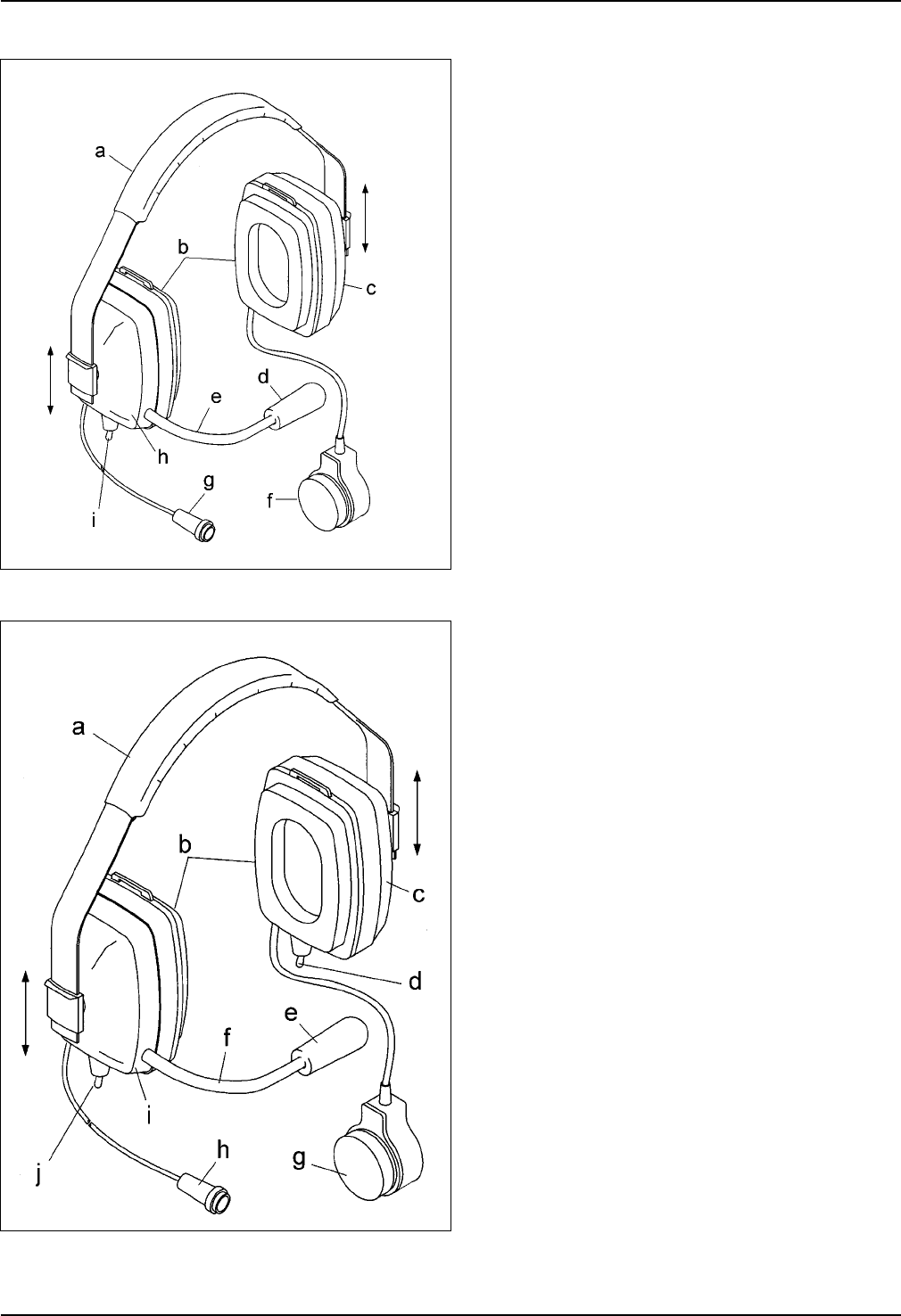
6
2.4.2 Headset, basic version
Fig. 2 Headset, basic version Key to Fig. 2
a Adjustable head band
b Ear cushions
c Left headset muff
d Microphone and windshield
e Flexible gooseneck
f Option – External PTT button with belt clip for
communication between the wing walkers, the
marshalling agent, and the tug driver
g Connecting cable and plug for the
Transmitter/Receiver Unit
CT-GateCom II.24/Multi
h Right headset muff
i On/Off switch for microphone
The 3-position microphone switch at the right
headset muff allows communication between
the wing walkers, the marshalling agent, and
the tug driver but not with the flight deck.
Information for the microphone switch see
section 2.4.6
2.4.3 Headset for tug driver
Fig. 3 Headset for tug driver Key to Fig. 3
a Adjustable head band
b Ear cushions
c Left headset muff
d On/Off switch for microphone
The 3-position microphone switch at the left
headset muff allows communication between
the tug driver and the flight deck. Information
for the microphone switch see section 2.4.6
e Microphone and windshield
f Flexible gooseneck
g Option – External PTT button with belt clip for
communication with the flight deck
h Connecting cable and plug for the
Transmitter/Receiver Unit
CT-GateCom II.24/Multi
i Right headset muff
j On/Off switch for microphone
The 3-position microphone switch at the right
headset muff allows communication between
the wing walkers, the marshalling agent, and
the tug driver but not with the flight deck.
Information for the microphone switch see
section 2.4.6
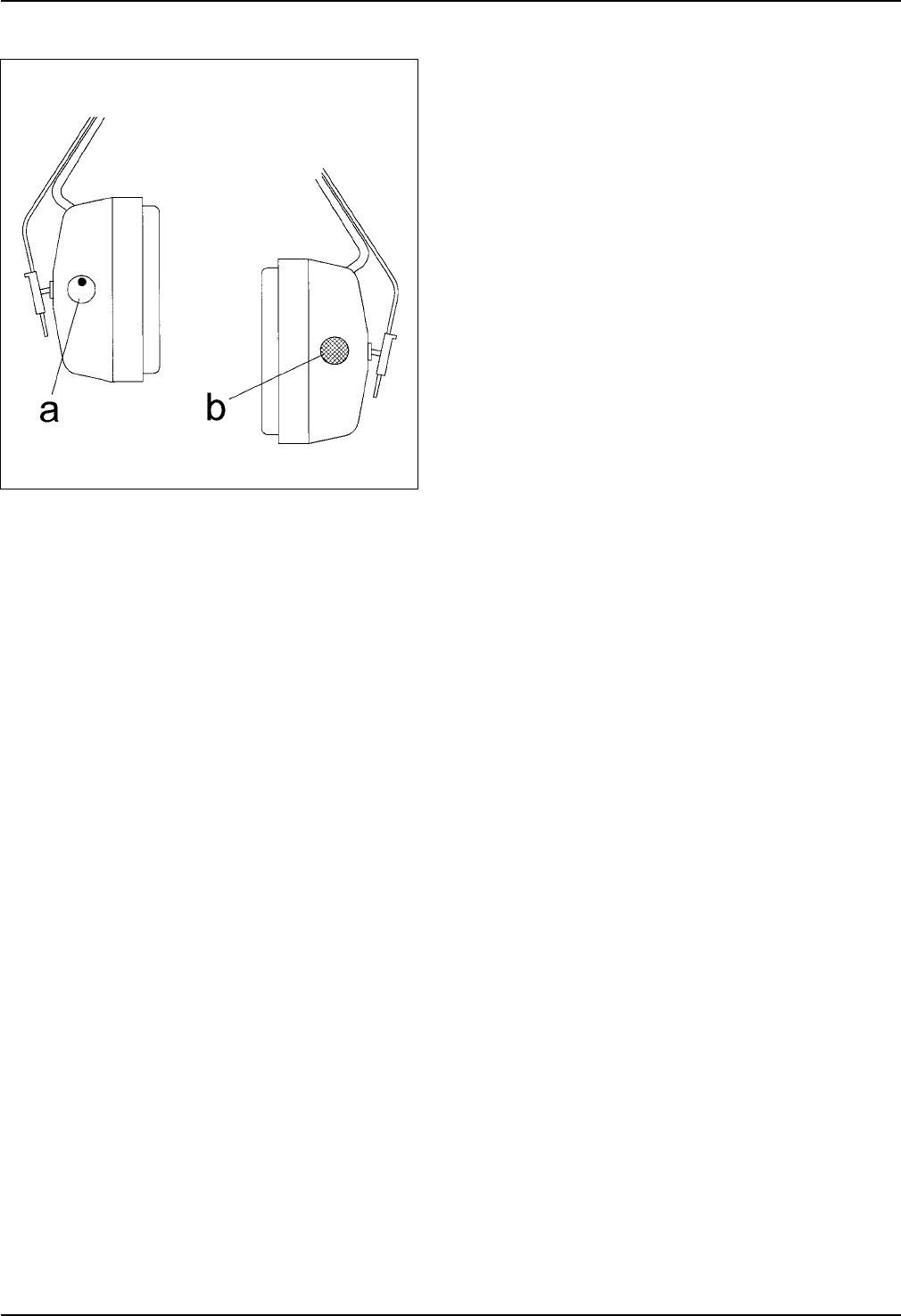
7
2.4.4 Headset with level-limited ambient sound reception
Fig. 4 Headset with level-limited ambient
sound reception
General – Headsets with level-limited ambient sound
reception (Fig. 4) are used mainly where ambient
sounds, warning signals etc. have to be heard
alongside communication. The external sounds are
received by a microphone (Fig. 4/b) on the front side of
the left-hand headset muff and are audible inside this
headset muff via the ambient sound speaker.
If the external sounds exceed 85 dB(A), the sound
level emitted to the ear by the ambient sound speaker
is limited electronically to a maximum of 85 dB(A).
The power for the ambient sound reception electronics
is supplied by the Transmitter/Receiver Unit CT-
GateCom II.24/Multi.
Switching On/Off and adjusting the volume for
ambient sound reception – The ambient sound
reception is switched on and off and volume controlled
by means of the additional combined On/Off switch
and volume adjuster (Fig. 4/a) on the headset muff.
2.4.5 Audio signals used
Two different audible tones are used for signaling the operating status via the headset connected to the
Transmitter/Receiver Unit. The tone for the indication of positive responses (P-tone) has a higher
frequency than the tone for the indication of negative responses (N-tone). Signaling of the various
events is effected by a varying number of consecutive P-tones or N-tones.
Positive acknowledgement tone
All positive responses are indicated by a high P-tone.
Negative acknowledgement tone and error tone
All negative responses and error status are indicated by a low N-tone.
Examples battery warning
If the battery has an undervoltage a low 3-beep N-tone sequence »N-N-N« sounds approximately every
10 seconds in the Headset.
Examples range warning
If the range limit is reached, a high 3-beep P-tone sequence »P-P-P« sounds approx. every 5 seconds
in the Headset.
2.4.6 On/Off switch for the microphone
The microphone of the headset can be switched on and off with the microphone switch »PTT.–OFF–
HOT.« at the bottom of the headset muff(s). Three switch positions are possible. However,
communication can only be performed after on-air subscription (sections 3...3.4) that is carried out ex-
works, switching on, synchronization, adjustment of the speaker volume (sections 4...4.3) and
connection setup (sections 4.4...4.4.2) have all been effected.
Middle position »OFF« (receive): The headset microphone is switched off. You can only receive.
Front switch position »PTT« (transmit and receive): »PTT« position (PTT = push-to-talk).
The headset microphone is switched on. You can speak into the microphone as long as you hold the
switch in this position and simultaneously a message is being received. After releasing the switch, the
switch returns to the middle position »OFF«.
Rear »fixed« switch position »HOT« (transmit and receive): »Hot mic« position.
The headset microphone is constantly switched on. You can speak into the microphone and
simultaneously receive a message.
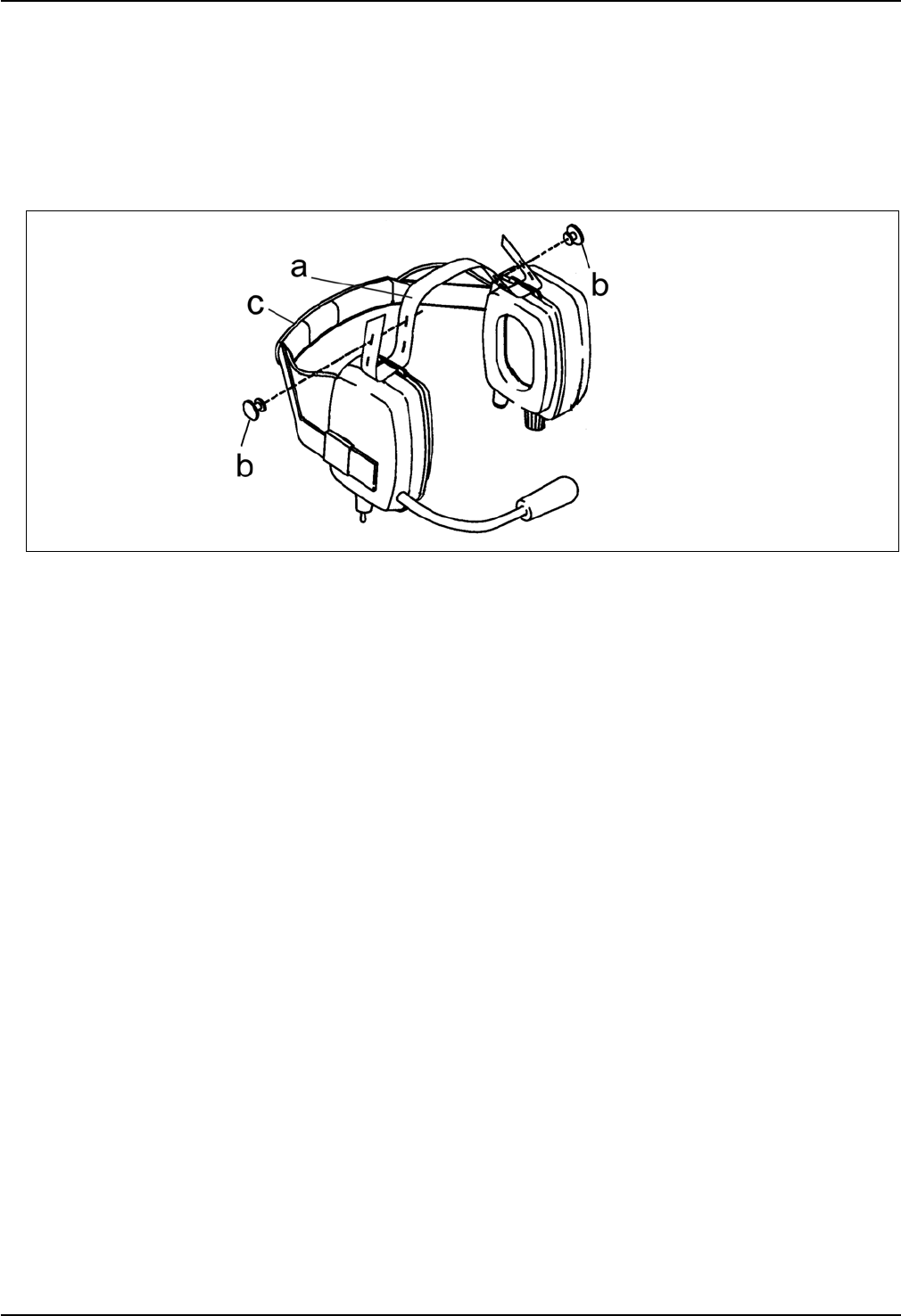
8
2.4.7 Wearing the headset with an additional head strap
In the event of rapid body movements or extreme body postures or if you are using a protective helmet
the headset can be additionally secured on your head by means of the head strap (Fig. 5/a) provided.
a. Pull the head strap as per Fig. 5 through the slit in the headset muffs and fasten it with the two
retainers (Fig. 5/b).
b. Put on the headset, fold the head band (Fig. 5/c) to the rear and wear the head band as a neck
band. Ensure that the head strap and neck band are tautly seated.
Fig. 5
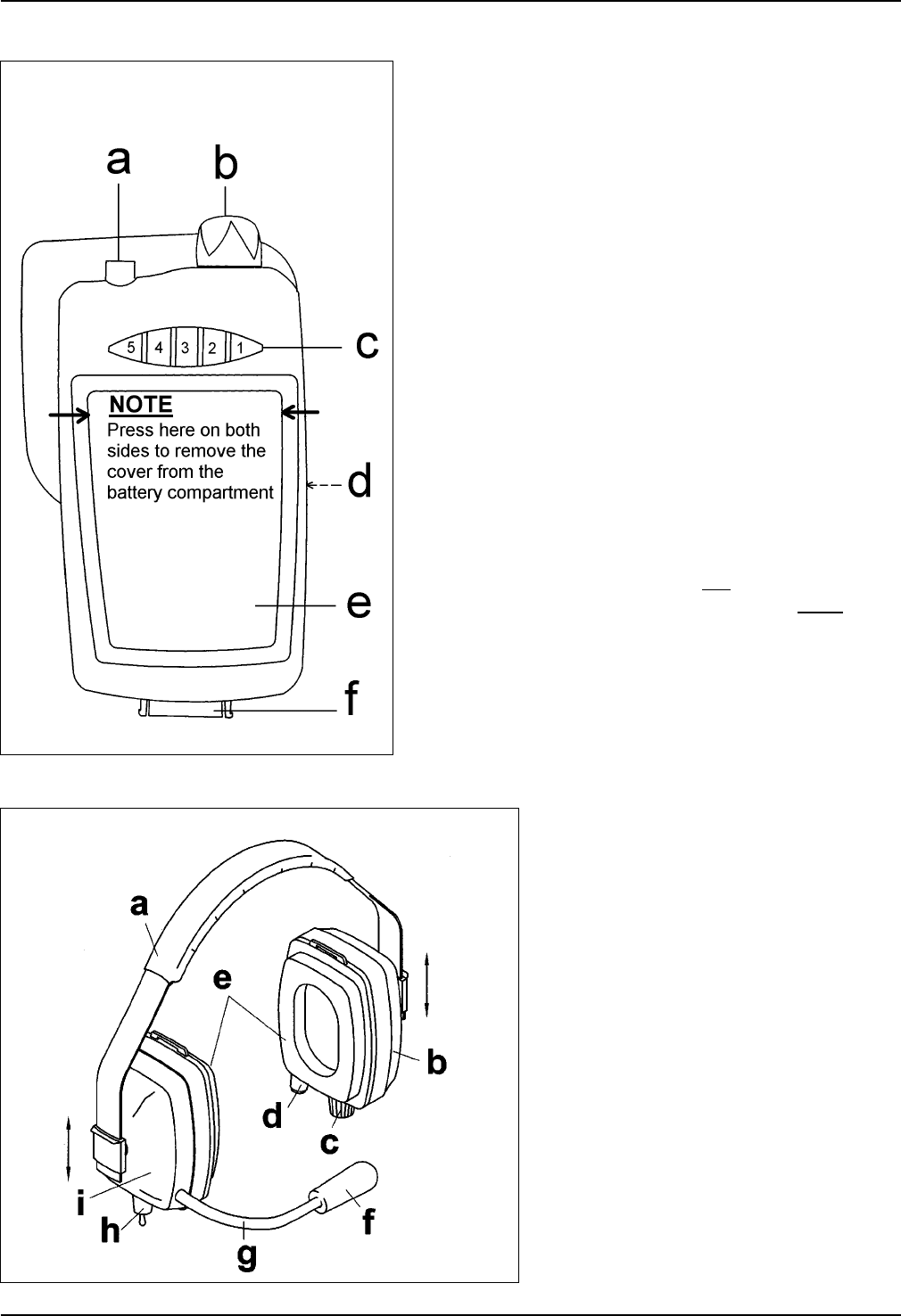
9
2.5 Transmitter/Receiver Unit CT-GateCom II.24/Multi
Fig. 6 Transmitter/Receiver Unit
CT-GateCom II.24/Multi
The wing walkers, the marshalling agent and the tug
driver have Transmitter/Receiver Units
CT-GateCom II.24/Multi which are used in conjunction
with the headsets. They are worn on waist belt by means
of a fastening clip on the rear.
The Transmitter/Receiver Unit is used for communication
over short distances. The max. range depends on the
local circumstances. Protection against eavesdropping is
ensured by the digital design. Channel selection is
effected automatically by the unit.
Power for the Transmitter/Receiver Unit is supplied by a
removable Li-Ion 3.6 V/2300 mAh rechargeable battery
pack which resides in a battery compartment in the unit.
Key to Fig. 6
a Jack for connection of the headset
b On/off switch and volume control (rotary knob)
c Bank of 5 push-buttons (red or black)
Buttons 1 and 5 for on-air subscription
Buttons 2, 3 and 4 for connection setup and
connection release
The tug driver and the marshalling agent have
Transmitter/Receiver Units with red colored push-
button bank and the two wing walkers with black
colored push-button bank.
d Fastening clip on the rear to fasten the unit on waist
belt
e Removable cover for the battery compartment
f Multi-purpose jack, e.g. for programming or for
connection of accessories
2.6 Transmitter/Receiver Headset CT-GateCom II.24
Fig. 7 Transmitter/Receiver Headset CT-GateCom II.24 Instead of a Transmitter/Receiver Unit
CT-GateCom II.24/Multi (section 2.5) in
conjunction with a communication headset
(sections 2.4...2.4.7), the Transmitter/Re-
ceiver Headset CT-GateCom II.24 (Fig. 7)
can be used.
Key to Fig. 7
a Adjustable head band
b Left-hand headset muff
c On/Off switch and volume control
d Button for subscription, connection
setup and release
e Ear cushions
f Microphone and windshield
g Flexible gooseneck
h On/Off switch for microphone
i Right-hand headset muff
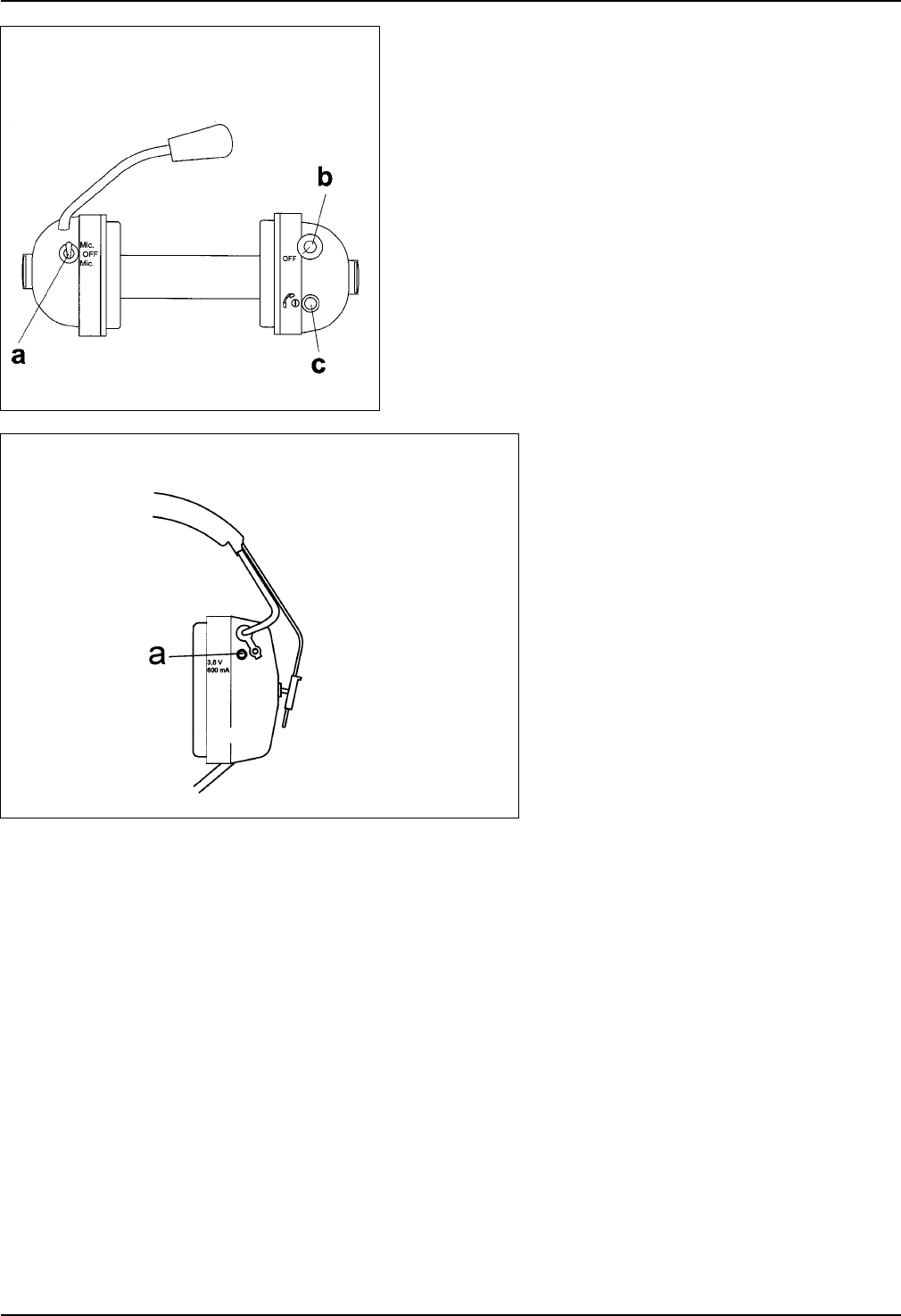
10
Fig. 8 Transmitter/Receiver Headset
CT-GateCom II.24, microphone
on/off switch (item »a«)
On/Off switch for the microphone
The microphone can be switched on and off with the switch
»Mic.–OFF–Mic.« (Fig. 8/a) at the bottom of the right-hand
headset muff. Three switch positions are possible.
Middle position »OFF« (receive): The headset
microphone is switched off. You can only receive.
Front switch position »Mic.« (transmit and receive):
The headset microphone is switched on. You can speak
into the microphone as long as you hold the switch in this
position and at the same time you can hear a received
message. After releasing the switch the switch returns to
the middle position »OFF«.
Rear »fixed« switch position »Mic.« (transmit and
receive): The headset microphone is constantly switched
on. You can speak into the microphone and at the same
time you can receive a message.
Fig. 9 Transmitter/Receiver Headset CT-GateCom II.24,
battery charging socket
Power supply
A 3.6 V/600 mAh NiCd rechargeable
battery or an optional 3.6 V/2300 mAh
Li-Ion rechargeable battery in the right
headset muff provides the power supply for
the headset.
The battery charging socket (see example
Fig. 9/a) is located on the rear of the right-
hand headset muff.
2.7 Aircraft Interface CT-GateCom II.24+4
The Aircraft Interface (Fig. 10) consists of Interface (Fig. 10/j) and Battery Pack (Fig. 10/c) which reside
in a carrying bag (Fig. 10/a). The carrying bag is closed by means of a zip. The unit is connected to the
aircraft intercom via connecting cable and male jack-plug (Fig. 10/k).
The Battery Pack contains a Li-Ion rechargeable battery 3.6 V/2300 mAh. It supplies the power for the
Interface. The Battery Pack can be charged via the charging socket (Fig. 10/d).
The weatherproof carrying bag is used to stow the Interface and the Battery Pack and can be attached
to the aircraft, e.g. the access cover for the aircraft intercom, by means of the carrying strap or a hook.
Î NOTE
zKeep the carrying bag closed when in use.
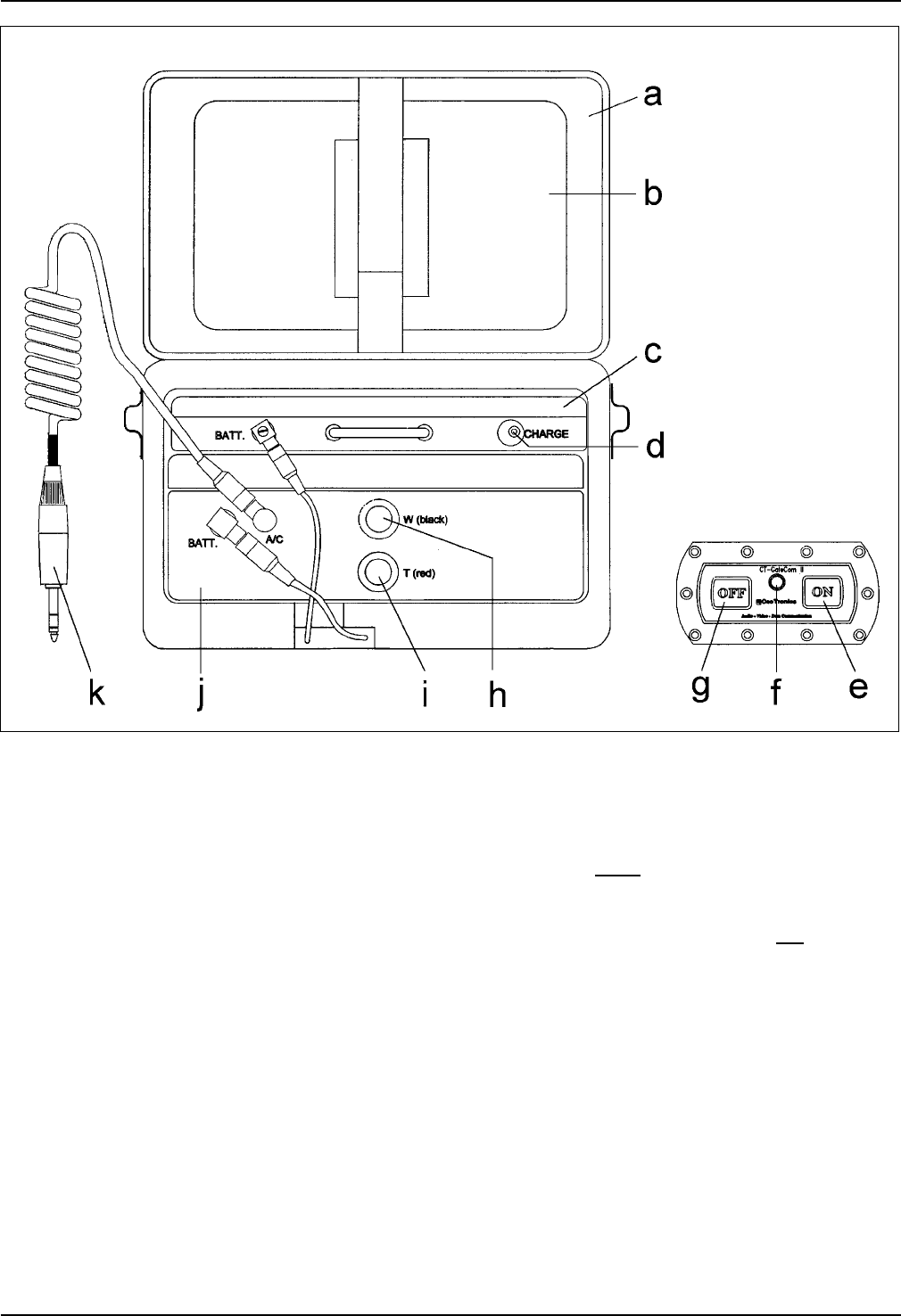
11
Fig. 10 CT-GateCom II.24+4/Aircraft Interface
Key to Fig. 10
a Carrying bag for the Interface and the Battery
Pack
b Stowage place for the coiled connecting cable
(item »k«)
c Battery Pack for the Interface. Equipped with a
Li-Ion rechargeable battery 3.6 V/2300 mAh in
the unit
d Charging socket »CHARGE« for the Li-Ion
rechargeable battery 3.6 V/2300 mAh in the
Battery Pack
e Green push-button »ON« to switch on the unit
f Control lamp, lights up if the unit is switched on,
flashes if the Battery Pack voltage is too low
g Red push-button »OFF« to switch off the unit
h Black subscription button »W« for the
Transmitter/Receiver Units group 2 for wing
walkers with black colored push-button bank
i Red subscription button »R« for the
Transmitter/Receiver Units group 1 for tug
driver and marshalling agent with red colored
push-button bank
j Interface
k Coiled connecting cable with male jack-plug for
connection to the aircraft intercom
2.8 Battery chargers
Two battery chargers are shipped with the system (see section 2.3). For recharging the batteries see
section 6 and the special CeoTronics Operating Instructions for the chargers.

12
3. On-air subscription
3.1 General
Î NOTES
zThe on-air subscription is a procedure which has to be performed once only ex-works.
It must be performed again only in the case of an error or if another Transmitter/Receiver Unit
CT-GateCom II.24 will be used in conjunction with the Aircraft Interface.
zIn the following the on-air subscription is described for the Aircraft Interface in conjunction
with Transmitter/Receiver Units CT-GateCom II.24/Multi. The on-air subscription for the
Aircraft Interface in conjunction with Transmitter/Receiver Headsets CT-GateCom II.24 is
carried out analogous and in the sequence as described in sections 3.2...3.4.
The subscription procedure is performed on the Aircraft Interface and the Transmitter/Receiver Units
manually by means of a procedure carried out by the operator.
The Aircraft Interface is equipped with two radio modules. The four Transmitter/Receiver Units are
equipped with one radio module each. Each unit (radio module) has its own identification number.
A max. of four Transmitter/Receiver Units (in two groups) is allocated to the two radio modules in the
Aircraft Interface. The Aircraft Interface is the base unit and the Transmitter/Receiver Units are
subscribed to the Aircraft Interface. First of all an allocation must always take place between the Aircraft
Interface and the Transmitter/Receiver Units.
Ex-works the four Transmitter/Receiver Units are divided in two groups as follows
(Fig. 10/i and h):
yGroup 1 – Transmitter/Receiver Units with red colored push-button bank for tug driver and
marshalling agent. The subscription is carried out by means of the red subscription button
»T« (Fig. 10/i) for group 1 at the Aircraft Interface
yGroup 2 – Transmitter/Receiver Units with black colored push-button bank for wing walkers.
The subscription is carried out by means of the black subscription button »W« (Fig. 10/h) for
group 2 at the Aircraft Interface
Other allocations in pairs can be carried out later by the customer. Please heed that the subscription of
the Transmitter/Receiver Units in conjunction with the Aircraft Interface is always carried out in pairs.
If a third Transmitter/Receiver Unit is subscribed to one of the two groups of the Aircraft Interface, the
Transmitter/Receiver Unit that was subscribed first is deleted from the data base of the Aircraft
Interface.
Once the subscription procedure has been successfully concluded, the identity of the communication
partners is stored in the data base of the Aircraft Interface and of the Transmitter/Receiver Units. A
Transmitter/Receiver Unit stores one Aircraft Interface, the Aircraft Interface stores in pairs up to four
(2 x 2) Transmitter/Receiver Units.
If the Aircraft Interface or a Transmitter/Receiver Unit is set to subscription mode and this is terminated
or not completed after 2 minutes without the subscription procedure having been successfully
concluded a »time out« occurs. After a »time out« the subscription procedure must be restarted.

13
3.2 On-air subscription of the first Transmitter/Receiver Unit of group 1
Î NOTE
zThe Transmitter/Receiver Units are subscribed in pairs (group 1 and 2 see section 1), but one
after the other, to the Aircraft Interface. First the two Transmitter/Receiver Units of group 1
are subscribed one after the other to the Aircraft Interface and then the two
Transmitter/Receiver Units of group 2 are subscribed one after the other to the Aircraft
Interface (see section 3.1).
zTwo Transmitter/Receiver Units can never be simultaneously subscribed to the Aircraft
Interface. The Transmitter/Receiver Units must always be subscribed one after the other to
complete a group.
zFor subscription the Aircraft Interface must always be switched on before the
Transmitter/Receiver Unit.
a. Connect the first headset of group 1 to the first Transmitter/Receiver Unit of group 1 (identifiable by
the red colored push-button bank) via the connecting cable and plug of the headset. Open the
carrying bag for the Aircraft Interface by means of the zip.
b. At the Aircraft Interface press the red subscription push-button »T« (Fig. 10/i) for group 1, keep the
red push-button »T« pressed and switch on the Aircraft Interface by means of the green push-button
ON (Fig. 10/e). The control lamp (Fig. 10/f) illuminates. After switching on keep the red subscription
push-button »T« pressed for at least 10 seconds. Than immediately carry out step »c«.
c. At the first Transmitter/Receiver Unit group 1 with red colored push-button bank press the
subscription button 1 simultaneous with subscription button 5 located at the begin and end of the
push-button bank (Fig. 6/c). Keep the two push-buttons pressed and switch on the
Transmitter/Receiver Unit by means of the On/Off switch and volume control (rotary knob Fig. 6/b).
After switching on keep the two push-buttons pressed for at least 10 seconds.
The subscription procedure on the Transmitter/Receiver Unit has to be started within 2
minutes after the subscription procedure on the Aircraft Interface was started, otherwise a
»Time Out« may occur (see section 3.1).
After approx. 30 seconds a high double-beep tone can be heard in the headset. This indicates that
the on-air subscription has been successfully completed. A second high double-beep tone finally
reports that the Transmitter/Receiver Unit has synchronized itself with the Aircraft Interface.
3.3 On-air subscription of the second Transmitter/Receiver Unit of group 1
a. Switch off the Aircraft Interface with the red push-button OFF (Fig. 10/g). The control lamp (Fig. 10/f)
extinguishes.
b. Connect the second headset of group 1 to the second Transmitter/Receiver Unit of group 1
(identifiable by the red colored push-button bank) by means of the connecting cable and plug of the
headset. Ensure that the Transmitter/Receiver Unit is switched off. The on/off switch and volume
control (rotary knob Fig. 6/b) must be set to OFF .
c. Repeat the subscription procedure for the Aircraft Interface and the second Transmitter/Receiver
Unit of group 1 as described in section 3.2, steps »b« and »c«, for the Aircraft Interface and for the
first Transmitter/Receiver Unit of group 1.
3.4 On-air subscription of the first and second Transmitter/Receiver Unit of group 2
The subscription procedure for the Aircraft Interface and the two Transmitter/receiver Units of group 2
(identifiable by the black colored push-button bank) is carried out as described in sections 3.2 and 3.3
for the two Transmitter/Receiver Units of group 1. At the Aircraft Interface the black subscription push-
button »W« (Fig. 10/h) for group 2 is used instead of the red push-button »T« for group 1 (Fig. 10/i).
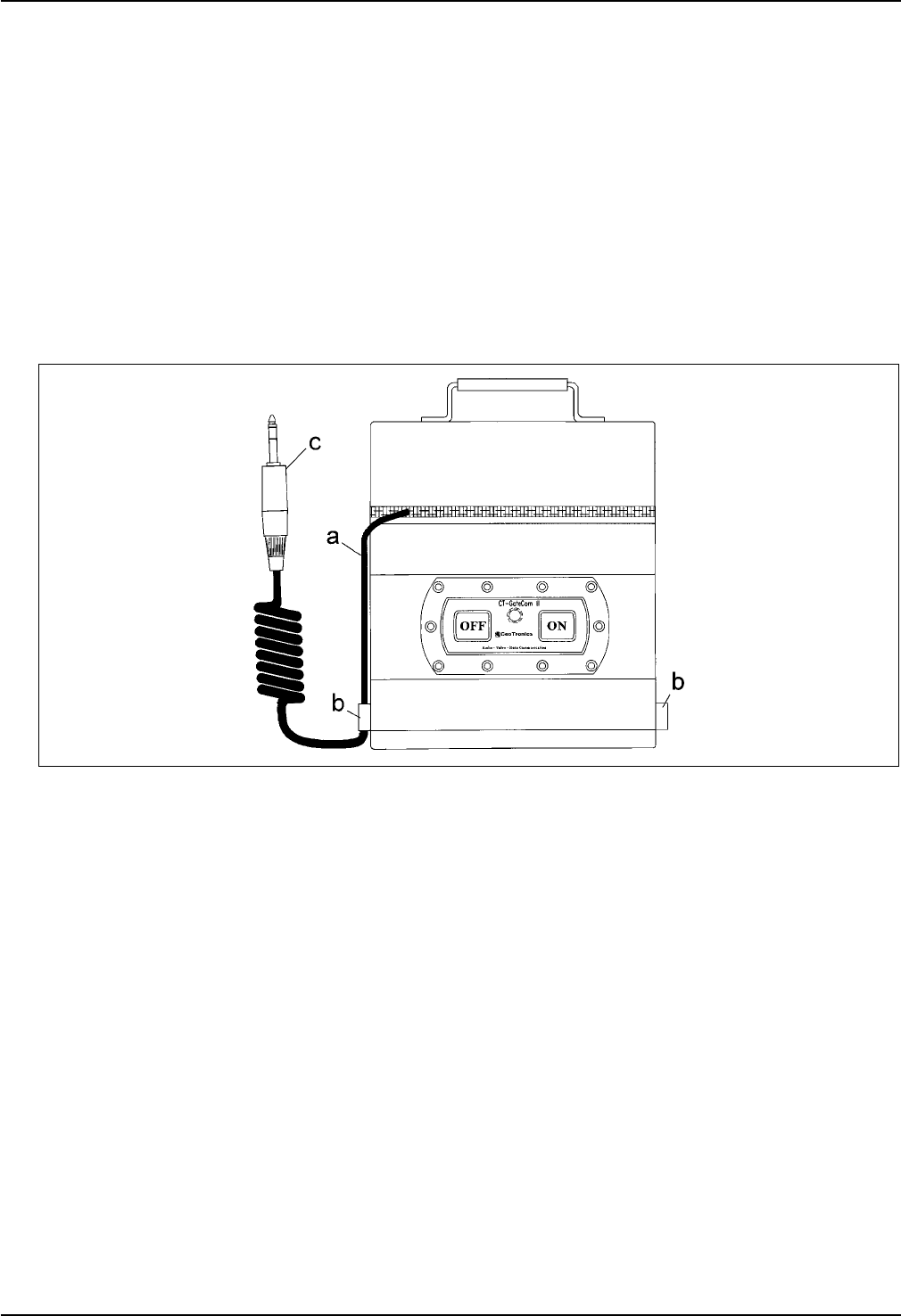
14
4. Commissioning and operation
Î NOTE
In the following the commissioning and operation of the system is described for the Aircraft
Interface and the Transmitter/Receiver Units CT-GateCom II.24/Multi which are used in
conjunction with communication headsets.
4.1 Aircaft Interface
The rechargeable battery in the Battery Pack must be fully charged.
a. Open the carrying bag for the Aircraft Interface by means of the zip.
b. Take the connecting cable (Fig. 11/a) with male jack-plug (Fig. 11/c) out of the cover of the carrying
bag. Lead the connecting cable with male jack-plug through one of the loops (Fig. 11/b) on the
carrying bag. Close the carrying bag by means of the zip. This prevents any fluids running along
the lead into the carrying bag.
Fig. 11
c. At the aircraft locate the aircraft intercom connector. Hang the carrying bag e.g. over the access
cover or to a suitable place near the aircraft intercom connector by means of the carrying strap or by
means of a hook.
Connect the Aircraft Interface via the connection cable and the male jack-plug to the female jack-
plug for the aircraft intercom.
Î NOTE
zKeep the carrying bag for the Aircraft Interface closed at all times while in use!
4.2 Headsets and Transmitter/Receiver Units
a. Connect the headset via the connecting cable and plug to its Transmitter/Receiver Unit. Fasten the
Transmitter/Receiver Unit by means of the clip on the rear to a suitable place on your clothing.
b. Put on the headset. Take care for a perfect comfortable fit. Only when the ear cushions are properly
located around the ears the best noise attenuation of the ear muffs is provided. Adjust the height of
each ear muff equally on both sides while holding the head band down until the ear cushions have a
tight and comfortable fit. The head band should sit straight and comfortable on the top of the head.
For hygiene reasons we recommend the use of the washable sweat absorbers on the ear muffs.
These are pulled over the ear cushions and are for the purpose of wear comfort and hygiene.

15
CAUTION
Do not »twist« the flexible gooseneck. Do not carry the headset by the gooseneck.
Use the microphone only with a windshield.
c. Adjust the flexible gooseneck by bending so that the microphone is located at a distance of approx.
5 mm (0.2 in.) in front your lips. Optimum voice transmission with the best possible noise
compensation is then provided.
4.3 Switching on, adjusting the speaker volume
Î NOTES
zThe Aircraft Interface must always be switched on before the Transmitter/Receiver Units.
zOn the Transmitter/Receiver Units the push-buttons 2,3,4 for connection setup and
connection release, placed in the middle of the push-button bank (Fig. 6/c), must not be
pressed until the Transmitter/Receiver Units are synchronized with the Aircraft Interface.
zAlways leave the Aircraft Interface and the Transmitter/Receiver Units switched on as long as
you work with the communication system so that immediate availability of the system is
provided.
a. First switch on the Aircraft Interface by means of the green push-button ON (Fig. 10/e). The control
lamp (Fig. 10/f) illuminates. If the Battery Pack voltage is too low the control lamp flashes and the
Battery Pack must be charged.
b. Switch on the Transmitter/Receiver Unit by means of the On/Off switch and volume control (rotary
knob Fig. 6/b).
After Switching on the connection synchronization between Transmitter/Receiver Unit and Aircraft
Interface is effected automatically.
Synchronization: A click is audible in the headset connected to the Transmitter/Receiver Unit
approximately 10 seconds after switching on. The synchronization procedure then begins, i.e. the
previously switched on Aircraft Interface seeks its Transmitter/Receiver Unit. This synchronization
procedure can last approx. 30 seconds. Upon completion of synchronization – i.e. the Aircraft
Interface has found its Transmitter/Receiver Unit – a high double-beep P-tone sounds in the
headset, indicating that the Transmitter/Receiver Unit and the Aircraft Interface are ready for
operation.
c. At the Transmitter/Receiver Unit set the On/Off switch and volume control (rotary knob Fig. 6/b) to
mid-position. Later, on voice reception, adjust the desired speaker volume for your headset. Do not
set the volume any higher than necessary.
d. Connection setup and release by the Transmitter/Receiver Units see sections 4.4...4.4.2.
4.4 Connection setup and release by the Transmitter/Receiver Unit(s)
4.4.1 Prerequisites
yAircraft Interface and Transmitter/Receiver Unit(s) subscribed (sections 3...3.4)
yAircraft Interface and Transmitter/Receiver Unit(s) switched on and synchronized (section 4.3)
4.4.2 Connection setup and release
Automatic connection setup after switching on
After the Aircraft Interface and the Transmitter/Receiver Unit(s) are switched on the connection
synchronization between the the Aircraft Interface and the Transmitter/Receiver Unit(s) is(are) effected
automatically. Subsequently communication is possible.
Connection release
Briefly press one of the push-buttons for connection setup and release in the middle of the push-button
bank (Fig. 6/c) at the Transmitter/Receiver Unit. The Transmitter/Receiver Unit is disconnected from the
Aircraft Interface. This procedure is acknowledged by a high beep P-tone in the headset connected to
the Transmitter/Receiver Unit.

16
Reconnection
Briefly press one of the push-buttons for connection setup and release in the middle of the push-button
bank (Fig. 6/c) at the Transmitter/Receiver Unit. In the headset connected to the Transmitter/Receiver
Unit a high beep P-tone sounds when the connection is set up between the Transmitter/Receiver Unit
and the Aircraft Interface.
4.5 End of operation
4.5.1 Aircraft Interface
a. At the end of the workshift, switch off the Aircraft Interface before any of the Transmitter/Receiver
Units.
b. Recharge the rechargeable battery in the Battery Pack.
4.5.2 Transmitter/Receiver Units CT-GateCom II.24/Multi
Switch off the Transmitter/Receiver Unit. Recharge the rechargeable battery.
4.5.3 Transmitter/Receiver Headsets CT-GateCom II.24
Switch off the headset. Recharge the rechargeable battery.
5. Safekeeping – storage
Store the cleaned devices in a clean, dry place at normal room temperature and in normal relative air
humidity.
6. Recharging the batteries
The rechargeable Li-Ion battery 3.6 V/2300 mAh in the Transmitter/Receiver Units and in the Battery
Pack of the Aircraft Interface should only be charged with the chargers supplied with the system (see
section 2.3). Otherwise the batteries may be damaged. The chargers are neither water-tight nor dust-
tight. Protect them against water, rain and dirt. They may only be used in rooms with normal relative air
humidity and temperature. Do not cover up the ventilation slots of the chargers.
CAUTION
Never use battery chargers to charge non-rechargeable batteries. Never open rechargeable
batteries or throw them into fire. Used (defective) rechargeable batteries are subject to special
waste disposal. Do not put them in the household refuse. Observe your local regulations !
CAUTION
Never charge a rechargeable battery in areas with an explosion risk – an explosion may result.
Charge and change rechargeable batteries only within a building or similar environment that
does not contain dangerous concentrations of volatile vapors.
Notice the special CeoTronics Operating Instructions for the chargers.
To charge the battery pack in the Transmitter/Receiver Unit, switch off the Transmitter/Receiver Unit,
remove the cover from the battery compartment and take out the battery pack as described on the
battery pack sticker. Charge the battery pack with the charging station for Li-Ion rechargeable batteries.
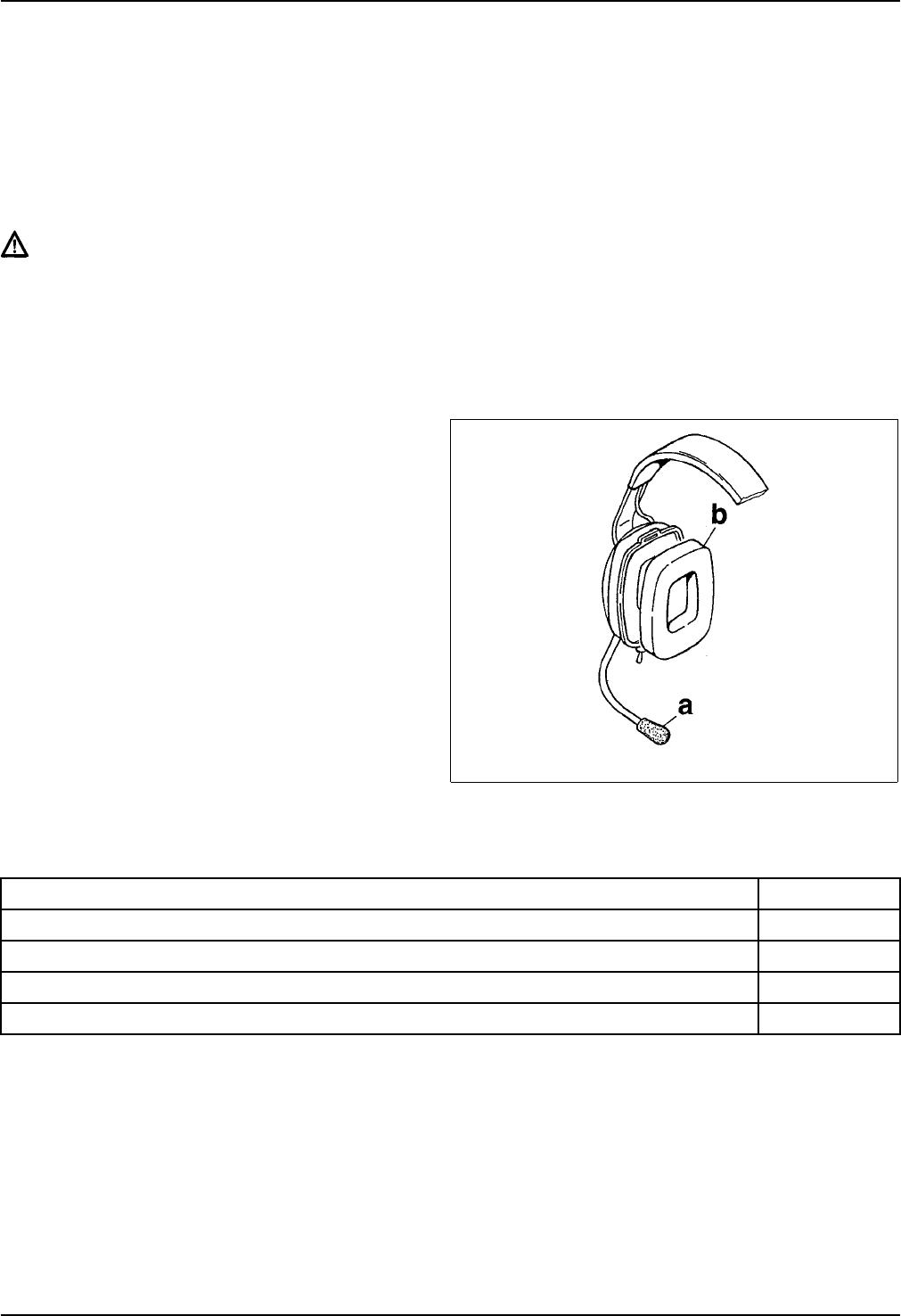
17
7. Maintenance
7.1 Visual inspection
Regularly examine the devices, the headset muffs, the ear cushions, the cables and plug connectors for
signs of fractures, cracks and wear. Send defective devices to CeoTronics for repair. Replace damaged
or worn ear cushions in accordance with section 7.4, and, even if not damaged, every 6 months of use
at the latest.
7.2 Cleaning
CAUTION
When cleaning ensure that no moisture penetrates inside the devices. Do not use any solvents
(e.g. benzine, alcohol, etc.) for cleaning purposes !
Remove any loose dust with a soft brush. Clean, if necessary, the outside of the devices with a suitable
clean cloth that has been slightly moistened with clear water, and rub the parts dry afterwards. If heavily
soiled, some dishwashing liquid can be used in addition.
7.3 Replacing the windshield on the
headset microphone
Pull the windshield (Fig. 12/a) off the microphone
and replace it.
7.4 Replacing the ear cushions of the
headset muffs
Pull the ear cushion (Fig. 12/b) off the headset
muff and replace it. Ensure that the new ear
cushion fully engages.
Fig. 12
8. Accessories and consumable parts
Designation and description Art. No.
Carrying case for headset, color grey 40 35 030
Ear cushion, 2 pcs. 50 00 501
Windshield for microphone, 10 pcs. 50 02 201
Comfort set consisting of 50 pcs. (25 pair-pack) sweat absorbing cotton pads 40 10 025

Germany and
International Sales
CeoTronics AG
Adam-Opel-Str. 6
63322 Rödermark (Germany)
Tel. +49-(0) 6074/87 51-0
Fax +49-(0) 6074/87 51-676
E-Mail verkauf@ceotronics.com
USA/Canada/Mexico
CeoTronics, Inc.
Battlefield Lakes – Tech Center II
533 Byron Street, Suite E
Chesapeake, VA 23320-6603
Tel. (757) 549-6220
Fax (757) 549-6230
E-Mail sales@ceotronicsusa.com
Great Britain and Ireland
CeoTronics Ltd.
1 Highview y High Street
BORDON, Hampshire
GU35 0AX
Tel. 01420-47 93 53
Fax 01420-47 93 72
E-Mail ceotronics@winweb.com
France
CeoTronics Sarl
Z.A. des Arpents
16, Rue du Pré aux Aulnes
77340 PONTAULT-COMBAULT
Téléphone 01 60 18 33 00
Télécopie 01 60 28 60 60
E-Mail ceotronics@worldonline.fr
Spain
CeoTronics S.L.
C/Antonio Vicent 23-1°
28019 Madrid
Tel. 91-460 82 50/51
Fax 91-460 31 93
E-Mail
ceotronics.gil@mad.canalpyme.com
Switzerland
CeoTronics AG
Grundstr. 16
6343 Rotkreuz
Tel. 041/790 58 38
Fax 041/790 58 39
E-Mail ceotronics@tic.ch
EIGENE/CT-GATECOMII/ZUL-USA.DOC/01/0901 y DOK 0357 Subject to change
Copyright © 9/2001 CeoTronics AG, 63322 Rödermark, Germany, Internet www.ceotronics.com